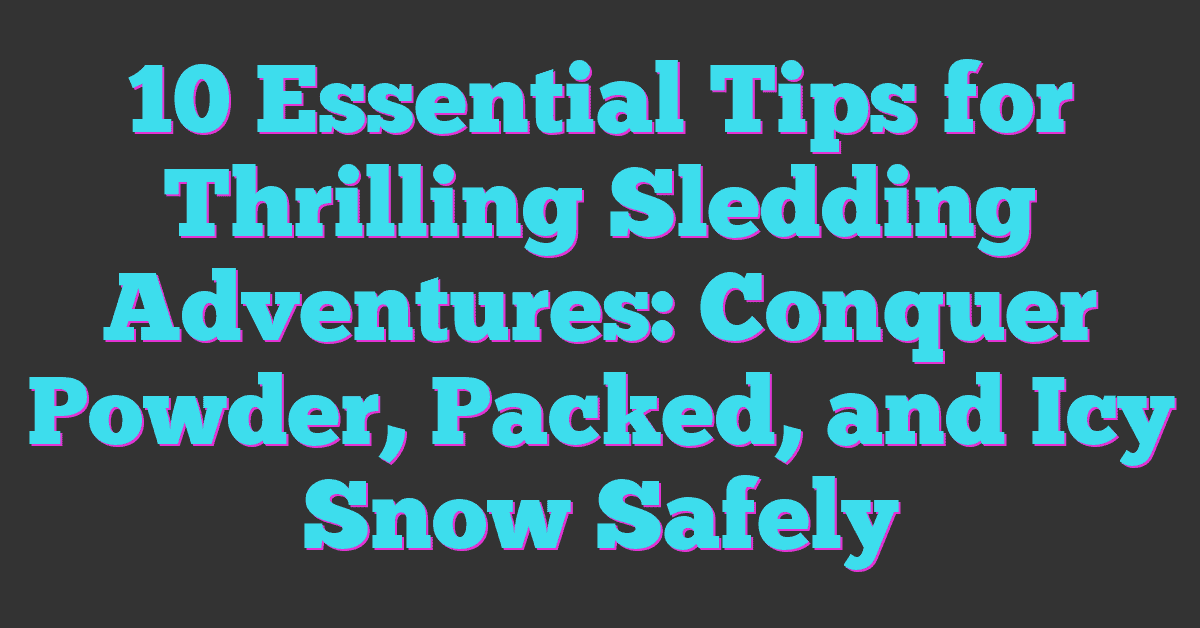Skiing can be an exhilarating adventure, but when the clouds roll in and visibility drops, it can turn into a daunting challenge. I’ve faced those foggy days on the slopes, and let me tell you, navigating through the mist requires a whole different set of skills. Whether it’s heavy snowfall, dense fog, or a storm rolling in, knowing how to handle low visibility can make all the difference between a fun day on the mountain and a frustrating one.

Understanding Low Visibility Conditions
Low visibility conditions pose unique challenges for skiers. Heavy snowfall and dense fog can drastically reduce sightlines, making navigation tricky. Here, I’ll break down the types and causes of low visibility to help you prepare better for your next snowy adventure.
Types of Low Visibility
- Fog: Fog significantly reduces visibility, often creating a whiteout effect. It can make familiar runs feel disorienting.
- Heavy Snow: Heavy snowfall can obscure trails and landmarks, altering your surroundings and making it difficult to judge distances.
- Night Conditions: Night skiing presents its own visibility challenges, even with adequate lighting. Lights create shadows that can hide obstacles.
- Blizzard Conditions: Blizzards combine wind, snow, and low clouds, creating near-total whiteouts. These conditions require utmost caution.
Causes of Low Visibility
- Weather Patterns: Sudden changes in weather, like storms or fronts, can create low visibility quickly. Keeping an eye on forecasts helps prepare for these shifts.
- Humidity Levels: High humidity can lead to fog formation. Even on clear days, moisture in the air can reduce visibility later on.
- Wind: Windy conditions can whip up snow, causing drifting and blowing snow that obscures vision. Knowing when to pause is crucial for safety.
- Time of Day: The sun’s position can play a role in visibility. Low angles during sunrise and sunset can create glare, affecting your sightlines.
Understanding these elements helps me stay safer and enjoy skiing even when visibility takes a hit.
Essential Gear for Low Visibility Skiing
Skiing in low visibility requires specialized gear that enhances safety and comfort. I’ve found that having the right equipment makes all the difference when tackling those tough conditions.
Ski Goggles and Visibility
Ski goggles play a crucial role in maintaining visibility. Opt for goggles with a high-contrast lens, like yellow or rose, to brighten up flat light conditions. Look for a wide field of vision to improve peripheral awareness. Anti-fog coatings and ventilation systems keep the lenses clear, minimizing distractions. When skiing in heavy snow, goggles with a darker tint help reduce glare while still allowing enough light for good visibility.
Appropriate Clothing Layers
Layering is key for managing warmth and moisture. I always start with a moisture-wicking base layer to keep sweat off my skin. For the mid-layer, choose something insulating, like fleece or down, to trap heat. An outer layer made of waterproof and breathable material keeps wind and snow at bay. Pay attention to gloves, socks, and hats, too; they should be warm and provide dexterity for handling gear adjustments. Visibility-enhancing colors on outer layers make it easier for others to spot me in low-light conditions.
Techniques for Safe Skiing in Low Visibility
Skiing in low visibility requires a few techniques to navigate safely. Maintaining control and awareness is key to enjoying the slopes even when conditions aren’t ideal.
Slowing Down and Controlled Turns
Slowing down helps to maintain control during low visibility. I avoid sharp turns and instead focus on making wide, gradual arcs. These smoother movements reduce the risk of losing balance and can be more forgiving if I encounter unseen obstacles. When I approach turns, I shift my weight slightly to the downhill ski while keeping my knees bent. This stance provides stability while allowing me to pivot smoothly.
Improving Spatial Awareness
Improving spatial awareness is crucial in these conditions. I often use landmarks, like trees or signs, to gauge distance and direction. When visibility decreases, I pay attention to my surroundings, especially the sounds of other skiers and the feel of the snow beneath my skis. I also check my speed regularly, making adjustments to stay within a safe range. Practicing these techniques not only enhances my safety but also boosts my confidence while navigating through the fog or snow.
Navigating the Slopes
Navigating in low visibility can be a challenge, but with the right strategies, I can still enjoy the thrill of the slopes.
Using Landmarks and Terrain
Knowing and recognizing landmarks is crucial when visibility drops. I rely on familiar features, such as distinct trees, rock formations, or trail markers, to orient myself. I also pay attention to the slope’s terrain and changes. For instance, I can feel the pitch of a hill even when I can’t see it. If there’s been recent snow, I determine the boundaries of my path by feeling variations in snow texture. Observing the trees helps; I ensure they stay well-spaced as points of reference. In dense fog or snowfall, I maintain a slower pace, staying mindful of these cues to avoid getting lost.
Communicating with Other Skiers
Effective communication with fellow skiers becomes essential in low visibility. I use clear verbal signals when I approach others, stating my intentions loudly enough for them to hear. When skiing in groups, I maintain a reasonable distance to avoid collisions. Gestures also work well; a simple hand signal can let others know I’m stopping or changing direction. I find engaging with others on the slopes creates a sense of camaraderie, which makes navigating in challenging conditions more enjoyable. If I spot someone in distress, I lend a hand, ensuring we all stay safe and connected despite the fog and snow.
Conclusion
Skiing in low visibility can be daunting but it doesn’t have to ruin your day on the slopes. With the right mindset and preparation I’ve found that these challenges can turn into memorable adventures. Embracing specialized gear and honing your skills really makes a difference.
Remember to take it slow and stay aware of your surroundings. Communicating with fellow skiers not only enhances safety but adds to the fun. So next time you find yourself in a snowy fog or under a blanket of clouds don’t shy away. Instead embrace the experience and enjoy every moment. Happy skiing!










